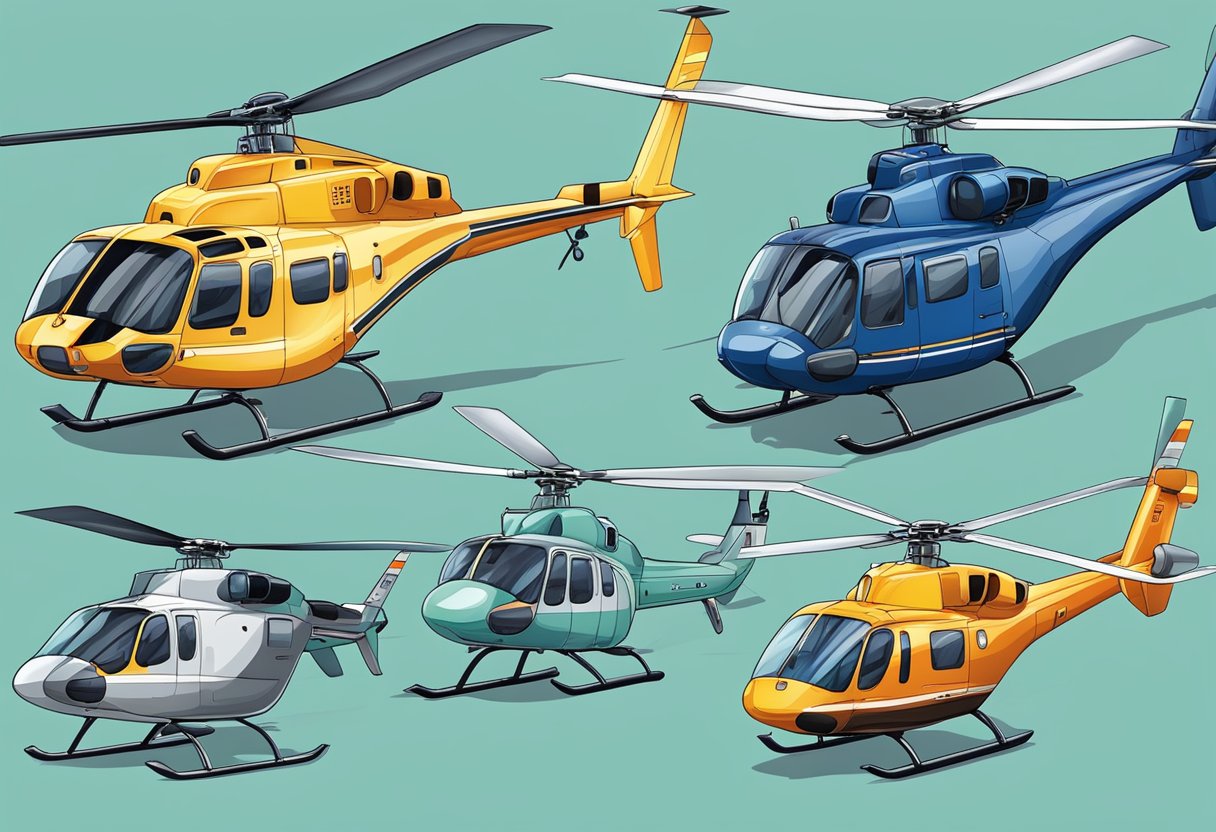Types Of Helicopters
Helicopters are a unique type of aircraft that are capable of vertical takeoff and landing, hovering in place, and flying in any direction. They are used for a variety of purposes, from military operations to search and rescue missions, and are an important part of the aviation industry.
To understand the different types of helicopters, it’s important to first understand the fundamental principles of helicopter flight. Unlike fixed-wing aircraft, helicopters use rotors to generate lift and thrust, allowing them to take off and land vertically and hover in place. They can also fly forward, backward, and sideways, making them highly maneuverable and versatile.
There are many different types of helicopters, each with its own unique design and capabilities. Some of the most common types include military attack helicopters, transport helicopters, and observation helicopters. Other types include medical helicopters, firefighting helicopters, and law enforcement helicopters. Each type is designed to meet specific needs and requirements, and they all play an important role in various industries and operations.
Key Takeaways
- Helicopters use rotors to generate lift and thrust, allowing them to take off and land vertically and hover in place.
- There are many different types of helicopters, each designed to meet specific needs and requirements.
- Helicopters are used for a variety of purposes, from military operations to search and rescue missions, and are an important part of the aviation industry.
Helicopter Fundamentals

Physics of Helicopter Flight
Helicopters are unique aircraft that can take off and land vertically, hover in place, and fly forwards, backwards, and sideways. Understanding the physics of helicopter flight is crucial to operating and flying these machines.
The main principle behind helicopter flight is lift. Lift is generated by the main rotor blades, which are shaped like airfoils and spin around a central mast. As the blades rotate, they create a difference in air pressure between the top and bottom surfaces of the blades, which generates lift. The amount of lift generated is directly proportional to the speed of the rotor blades and the angle of attack of the airfoils.
Another important concept in helicopter flight is torque. The main rotor blades generate torque, which causes the helicopter’s fuselage to rotate in the opposite direction of the rotor blades. To counteract this torque, helicopters use a tail rotor, which generates thrust in the opposite direction of the torque. The tail rotor is controlled by the pilot using the helicopter’s anti-torque pedals.
Helicopter Components
Helicopters are made up of several key components, each of which plays a crucial role in flight. The main components of a helicopter include:
-
Main rotor: The main rotor is the large rotor on top of the helicopter that generates lift and provides the helicopter with vertical takeoff and landing capabilities.
-
Tail rotor: The tail rotor is a smaller rotor on the tail of the helicopter that generates thrust in the opposite direction of the main rotor’s torque to keep the helicopter stable in flight.
-
Engines: Helicopters can have one or more engines, depending on their size and purpose. The engines provide the power necessary to spin the rotor blades and generate lift.
-
Landing gear: The landing gear is the system of wheels or skids that allows the helicopter to take off and land on the ground.
-
Cockpit: The cockpit is where the pilot sits and controls the helicopter’s flight using various instruments and controls.
Overall, understanding the fundamentals of helicopter flight and the various components that make up a helicopter is essential for anyone who wants to operate or fly these unique aircraft.
Types of Helicopters
Helicopters are versatile aircraft that can be used for a range of purposes, including transport, attack, search and rescue, and reconnaissance. There are several types of helicopters, each with its unique design and capabilities.
Single Main Rotor Helicopters
Single Main Rotor helicopters, also known as monocopters, are one of the most common types of helicopters. They have one large spinning blade, or rotor, for lift and a smaller tail rotor to counteract its torque. The two different-sized rotors allow the helicopter to maintain its balance and direction. Examples of Single Main Rotor helicopters include the Chinook and Huey.
Tandem Rotor Helicopters
Tandem Rotor helicopters have two rotors mounted one in front of the other. The rotors spin in opposite directions, which eliminates the need for a tail rotor. This design allows for greater lift and payload capacity. Tandem Rotor helicopters are often used for transport and military purposes. The Chinook is an example of a Tandem Rotor helicopter.
Coaxial Helicopters
Coaxial Helicopters have two rotors mounted on the same axis, spinning in opposite directions. This design eliminates the need for a tail rotor, making the helicopter more maneuverable. Coaxial Helicopters are often used for search and rescue and military purposes. The synchropter is an example of a Coaxial Helicopter.
Tiltrotor Helicopters
Tiltrotor Helicopters have rotors that can be tilted forward or backward, allowing them to take off and land vertically like a helicopter and fly forward like an airplane. This design gives them greater speed and range than traditional helicopters. The V-22 Osprey is an example of a Tiltrotor Helicopter.
Compound Helicopters
Compound Helicopters use a combination of rotor and fixed-wing technology to achieve lift and forward motion. They have a main rotor for lift and one or more additional rotors or jet engines for forward motion. Compound Helicopters are often used for military purposes.
In conclusion, each type of helicopter has its unique design and capabilities, making them suitable for various purposes. The choice of helicopter depends on the specific needs of the mission.
Helicopter Operations
Helicopters are versatile aircraft that are used for a wide range of operations, from military and defense to emergency medical services and law enforcement. Here are some of the most common uses of helicopters:
Military and Defense
Military helicopters are designed for a variety of missions, including attack, transport, and reconnaissance. They are used by the armed forces of many countries, including the United States, Russia, and China. Military helicopters are equipped with advanced weapons systems, radar, and navigation equipment, and they undergo extensive training to prepare for their missions.
Emergency Medical Services
Helicopters are often used in emergency medical services (EMS) to transport critically ill or injured patients to hospitals. Air ambulance helicopters are equipped with medical equipment and staffed by trained medical personnel, such as paramedics or nurses. They can transport patients quickly and safely, even in remote or hard-to-reach areas.
Law Enforcement and Surveillance
Police and law enforcement agencies use helicopters for a variety of missions, including surveillance, search and rescue, and tactical operations. Police helicopters are equipped with advanced sensors, such as thermal imaging cameras and radar, to help officers locate suspects and monitor criminal activity.
Search and Rescue Missions
Search and rescue missions are another common use of helicopters. Search and rescue helicopters are equipped with specialized equipment, such as winches and hoists, to rescue people from difficult or dangerous situations, such as mountainsides or rough seas.
Commercial and Civilian Use
Helicopters are also used for commercial and civilian purposes, such as transportation, agriculture, and firefighting. Transport helicopters are used to transport people and cargo, while agricultural helicopters are used to spray crops with pesticides or fertilizers. Firefighting helicopters are equipped with water tanks or buckets to drop water on fires.
In conclusion, helicopters are versatile aircraft that can be used for a wide range of operations. They are equipped with advanced technology and undergo extensive training to prepare for their missions. Whether it’s military and defense, emergency medical services, law enforcement and surveillance, search and rescue missions, or commercial and civilian use, helicopters play an important role in many different fields.
Technological Advancements and Innovations
High-Speed Helicopter Designs
In recent years, there have been significant technological advancements in the design of high-speed helicopters. These new designs incorporate more powerful turboshaft engines, modified rotor blades, and anti-torque tail rotors to achieve faster speeds and improved maneuverability. For example, the Sikorsky S-97 Raider is a high-speed helicopter that uses a tiltrotor aircraft design to achieve a top speed of 276 mph.
Unmanned Aerial Systems
The use of unmanned aerial systems, or drones, has revolutionized air support and reconnaissance operations. These systems can be equipped with a variety of sensors, including radar, to provide real-time intelligence to ground forces. Some drones are even armed with machine guns and missiles for offensive operations.
The incorporation of mast-mounted sensors, such as electro-optical/infrared cameras, has also improved the capabilities of unmanned aerial systems. These sensors provide a 360-degree view of the surrounding area, allowing for improved situational awareness and target acquisition.
Overall, these technological advancements and innovations have greatly improved the capabilities of helicopters and unmanned aerial systems in a variety of military and civilian applications.
Helicopter Training and Certification
Becoming a helicopter pilot requires proper training and certification. The Federal Aviation Administration (FAA) regulates helicopter pilot training and certification in the United States. The FAA sets the standards for training and certification, which are designed to ensure that pilots are competent and safe.
To become a helicopter pilot, one must first obtain a Private Pilot Certificate. This certification allows one to fly helicopters for recreation and is required to begin Commercial Pilot Certificate training. The Commercial Pilot Certificate is necessary to fly people or property for compensation or hire.
There are different types of helicopter pilot training courses available, including private, commercial, and instrument training. Private training is the foundation of flight training, and it is designed to teach the basics of flying. Commercial training is more advanced and focuses on flying for compensation or hire. Instrument training is designed to teach pilots how to fly in low visibility conditions using instruments.
When choosing a flight school for helicopter training, consider the instructors’ experience, career requirements, as well as safety records and the reputation of the school. It is also essential to ensure that the flight school is certified by the FAA.
Navigation and flight regulations are also crucial aspects of helicopter pilot training. Pilots must be familiar with navigation techniques, airspace rules, and other flight regulations. Safety is a top priority in helicopter pilot training, and pilots must be trained to handle emergency situations.
In summary, helicopter pilot training and certification are essential for anyone who wants to become a helicopter pilot. Proper training and certification ensure that pilots are competent and safe, and they can fly helicopters for recreation or for compensation. When choosing a flight school, it is essential to consider the instructors’ experience, career requirements, as well as safety records and the reputation of the school.






